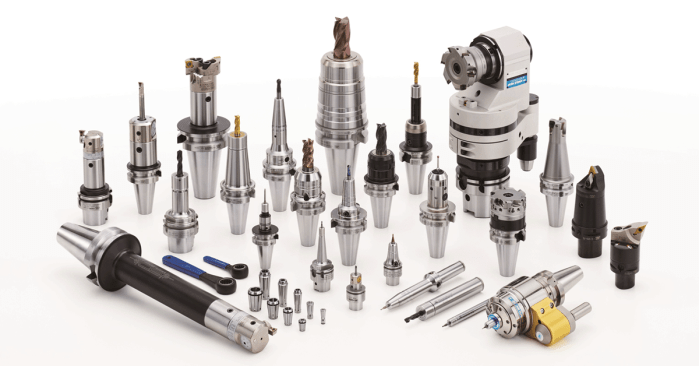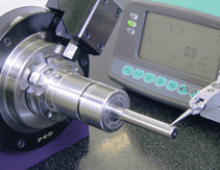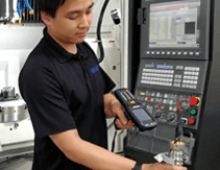La guía definitiva para optimizar el proceso de configuración de tus herramientas
Desde la búsqueda de empleados calificados hasta la capacitación de nuevos trabajadores y el aumento constante de las tarifas por hora, los problemas laborales abundan en la industria metalmecánica. De hecho, mientras que la productividad (producción por hora) se ha mantenido bastante estancada desde principios de la década de 2000, las tarifas por hora han aumentado considerablemente, según la Oficina de Estadísticas Laborales de EE. UU.
Y para muchos talleres, la configuración puede ser el asesino silencioso del tiempo. No solo aumenta las horas trabajadas por los empleados, sino que también reduce el valioso tiempo activo de mecanizado. Reducir solo 15 minutos en cada configuración puede traducirse en decenas, incluso cientos, de miles de dólares en ahorros anuales. Pero ¿por dónde empezar? Sigue leyendo para saber más.
Optimiza con las herramientas adecuadas
Existen ciertas herramientas, equipos y accesorios que favorecen tiempos de configuración más cortos, pero también importa cómo se utilizan.
Asegúrate de que las herramientas, husillos y accesorios estén diseñados para trabajar juntos
El uso de herramientas de baja calidad —o combinaciones de herramientas, husillos y accesorios que no estén diseñados para funcionar en conjunto— resulta en tiempos de mecanizado más largos y una vida útil más corta de los componentes. Y cuanto más corta sea la vida útil, más frecuentemente tendrás que reemplazar herramientas y accesorios, y más horas se invertirán en configuraciones.
Con las herramientas y portaherramientas, por ejemplo, suele cumplirse el dicho “obtienes lo que pagas”. Los portaherramientas más baratos pueden durar solo seis meses antes de presentar problemas de descentramiento. También es importante asegurarse de que tu portaherramientas y tu husillo sean compatibles (idealmente, ambos con licencia). Usar un portaherramientas sin licencia en un husillo licenciado puede afectar la vida de la herramienta y dañar la máquina.
Realiza trabajo fuera de la máquina
Quizá una de las mejores formas de reducir de inmediato el tiempo de configuración sea mantener los husillos girando, incluso mientras se prepara el siguiente trabajo.
Los preajustadores—disponibles en versiones de sobremesa o independientes—miden las geometrías de las herramientas antes de colocarlas en el husillo de la máquina. Esto elimina la necesidad de hacerlo directamente en la máquina, lo que permite mantener la producción en marcha. Los ahorros pueden ser significativos—y son bastante sencillos de calcular.
De hecho, un proveedor del sector petrolero redujo su tiempo de configuración en un 60 % y logró un ahorro anual superior a los $81 000.
Para un ensamblaje de herramientas cuidadoso y preciso fuera del husillo, considera un dispositivo de sobremesa, como la serie Tool Pro. Con una amplia variedad de adaptadores intercambiables y hasta dos ejes de rotación, se adapta fácilmente a múltiples tipos de conos y herramientas voluminosas.
Pásate a lo digital
La revolución digital está acelerando todo tipo de operaciones de manufactura. En lo que respecta a la configuración de herramientas, varias innovaciones digitales pueden mejorar la eficiencia. Las cabezas de mandrinado digitales, por ejemplo, facilitan que los operadores vean y realicen ajustes de diámetro extremadamente precisos. La próxima generación de esta tecnología permite mayor interactividad y control remoto (mediante aplicaciones) para configuraciones aún más rápidas.
Volviendo al tema de los preajustadores, SPI (Simple Post Interface) reduce el número de pasos necesarios en la máquina. En lugar de que un operador copie los datos del preajustador en el control, SPI utiliza códigos QR que son leídos por el módulo SPI en el control de la máquina. SPI incluso puede enviar las mediciones directamente a la máquina, sin una sola interacción manual.
SPI puede complementarse con el sistema de gestión de herramientas INTELLIGO para monitorear rápidamente y a distancia el conteo y la vida útil de las herramientas, evitando así recorridos innecesarios por el taller en busca de reemplazos.
Elige soluciones de sujeción eficientes
Elegir la solución de sujeción adecuada puede aumentar la eficiencia de la configuración—especialmente si ya invertiste en un preajustador. Una sujeción imprecisa, no repetible o lenta puede anular el tiempo ahorrado en la preparación externa. Cuatro factores clave te ayudarán a elegir las soluciones de sujeción más eficientes: tamaño de la pieza, forma de la pieza, mezcla de producción e interacción del operador. Obtén más información sobre cómo estos factores deben influir en tu elección de sistemas de sujeción aquí.
Refuerza las medidas de seguridad
La seguridad es fundamental en el taller y comienza desde la configuración. Desde la necesidad de reducir la interacción en un mundo post-Covid hasta la seguridad en el manejo general, hay mucho que tener en cuenta.
Reduce las interacciones con las herramientas
Reducir la cantidad de veces que un operador manipula una herramienta disminuirá orgánicamente el riesgo de lesiones. Es un concepto simple con soluciones igualmente simples: una mejor organización de herramientas, ya sea mediante métodos tradicionales o con el sistema INTELLIGO mencionado anteriormente.
Evita el uso de herramientas caseras
En muchos talleres, la configuración implica cierto grado de improvisación. Pero estos accesorios improvisados—como una “barra de fuerza” en lugar de una llave dinamométrica adecuada para apretar las tuercas del portaherramientas—pueden aumentar el tiempo de configuración cuando surgen problemas o retrabajos, e incluso dañar las máquinas y otros equipos.
Manipula los componentes pequeños con especial cuidado
La configuración se vuelve especialmente difícil, lenta y arriesgada con herramientas pequeñas y delicadas. No existe una solución única, pero la capacitación es clave. Los talleres que realizan micromecanizado deben invertir en formación específica para el manejo de herramientas pequeñas y especializadas. En algunos casos, puede haber accesorios que hagan la configuración más rápida, sencilla y segura—por ejemplo, extractores y eyectores para pinzas pequeñas.
Mantén el mantenimiento adecuado en mente
Cuando los operadores comienzan una nueva configuración, el mantenimiento suele ser una idea secundaria. Pero un mantenimiento continuo y constante antes de la configuración puede contribuir en gran medida a reducir el tiempo y los costos.
Verifica y conserva el rendimiento del husillo
El mantenimiento del husillo de la máquina garantiza configuraciones más rápidas y precisas. Ciertas herramientas facilitan el trabajo—como el calibrador cerámico Dyna Contact para una verificación visual de la precisión del cono. Puedes comprobar el descentramiento y la fuerza de sujeción del husillo con la barra de prueba Dyna Test y el Dyna Force, respectivamente. También es fundamental revisar y mantener el mecanismo de sujeción del husillo para asegurar la calidad de la pieza terminada y evitar daños en la máquina.
Aprieta los portaherramientas con cuidado
Como se mencionó en el ejemplo de la “barra de fuerza”, evita usar herramientas caseras o inadecuadas para tareas de apriete de portaherramientas. Estos métodos dificultan lograr el par de apriete correcto, lo que puede dañar la tuerca y acortar la vida útil de la herramienta. Invierte en una llave dedicada, diseñada para el trabajo y que facilite el proceso.
Limpieza adecuada para mejores resultados
Una configuración de herramientas ideal es imposible si las superficies tienen suciedad, grasa u otros residuos. Todos los puntos de contacto entre la herramienta, el husillo, la pieza y los dispositivos de sujeción deben estar limpios y lisos al inicio de cada trabajo. Pero limpiar no tiene por qué retrasar la configuración. Ten a mano accesorios que agilicen estas tareas—como limpiadores de conos, de alojamientos de herramienta y de husillos. Otros accesorios pueden garantizar el estado óptimo de los portapiezas (especialmente importante en aplicaciones de mecanizado multieje). Para los sistemas de sujeción de punto cero, considera tapones, racores planos sellados, mordazas con soplado de aire, perillas de viruta (para proteger los conos de centrado), protectores contra polvo y un conjunto de filtro/regulador/lubricador.
Reducir el tiempo de configuración requiere… preparación. Pero una vez que tengas las soluciones y procesos adecuados en su lugar, verás mejoras reales casi de inmediato, tanto en productividad como en rentabilidad. Comienza contactando a tu representante de BIG DAISHOWA para descubrir cómo los portaherramientas, sistemas de mandrinado, dispositivos de sujeción y preajustadores de primera calidad pueden ayudarte a optimizar la eficiencia de configuración.
¿Te pareció interesante o útil? Haznos saber tu opinión agregando tus comentarios o preguntas a continuación.



















Añadir nuevo comentario